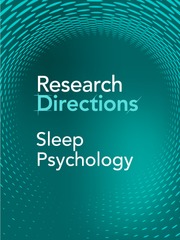Context
Daily rhythms are primarily synchronized by the suprachiasmatic nucleus (SCN) in the hypothalamus, the body’s central circadian clock. The SCN aligns whole-body cellular, behavioral and phenomenological processes with the Earth’s 24-hour day/night rhythm. When disruptions to the SCN’s perceptual system occur (e.g., “jet-lag,” prolonged waking, chronic exposure to light at night or habit change as the result of becoming a parent), disrupted melatonin and glucocorticoid secretion can lead to widespread dysregulation of sleep and circadian cycling. The effects of circadian disruptions are often compounded by the homeostatic sleep drive, wherein sleep pressure accumulates with protracted wakefulness to affect mood, cognition, health and well-being.
Some individuals are at greater risk for development of sleep and circadian disturbances, while others in similar circumstances are unaffected. It is unclear what risk factors may predispose an individual to such disruption, and inversely, what factors may be protective. It has been postulated that many variables – age, sex, genetic haplotype, biological chronotype, photosensitivity, retinal activity, health behaviors, coping strategies, socioeconomic factors, chronic stress, subjective diurnal preference, emotional and sleep reactivity and personality, among others – bear significance to an individual’s risk for sleep and circadian disturbance (reviewed in Chellappa Reference Chellappa2021). Psychophysiological processes have been implicated, as in the case of pubertal hormone expression being associated with risk for sleep-disrupting (alcohol and substance use, sensation seeking) behaviors in adolescents with an evening circadian preference (Dolsen et al 2019). Alternately, risk could vary along physiological or genetic mechanisms, such as older adults possibly experiencing attenuated light-response melatonin suppression because of waning pupil size and reduced clarity of the optic lens (Salvi et al Reference Salvi, Akhtar and Currie2006), or expression of specific genetic polymorphisms (reviewed in Casale and Goel Reference Casale and Goel2021; Tkachenko and Dinges Reference Tkachenko and Dinges2018). Environmental factors such as access to green space, obesogenicity of the built environment (e.g., walkability), social fragmentation, light and noise pollution and neighborhood socioeconomic status (SES) alter the individual’s experience and may increase the risk of developing sleep and circadian disturbances, including changes in sleep duration, quality, latency and signs of sleep-disordered breathing (Billings et al Reference Billings, Hale and Johnson2020).
Recent scholarly pursuits have generated a wave of unanswered questions related to the factors that influence individual differences in vulnerability/resilience to sleep deprivation and circadian misalignment. Notably, we do not yet understand the mechanism(s) responsible for photosensitivity among blue-light-sensitive and resistant individuals; the relevance (i.e., effect size) of individual factors (e.g., chronotype) on the propensity to experience circadian misalignment and sleep disturbances; the extent to which subjective sleepiness and related psychological constructs are trait-like; practical ways to measure individual differences in sleep and circadian disruption that still allows for robust and detailed ambulatory measurement in large-scale observational or quasi-experimental studies; the utility of animals in addressing the mechanisms of sleep and circadian disruption; the long-term effects of exposure to environmental factors that influence risk for circadian misalignment; the degree to which neighborhood SES differences are a causal factor in sleep and circadian disturbances (or alternatively, if differences in neighborhood composition are the stronger mechanism); nor how can we move toward truly personalized interventions with the capacity to target the social and built environments along with an individual’s unique needs to bring circadian cycling into better realignment and sleep sufficiency.
We invite papers that offer insights into:
-
How an individual’s biology (photosensitivity, chronotype, gene haplotype and gut microbiome) measurably and meaningfully impacts an individual’s propensity to experience sleep or circadian disruption
-
Studies, reviews or opinion pieces articulating the strengths and weaknesses of using animal models to investigate individual differences in sleep and circadian disturbances (e.g., comparison of inbred vs. outbred strains, transgenic strains)
-
Mechanisms through which environmental (social fragmentation, neighborhood, light at night, noise and air pollution) determinants influence an individuals’ propensity to experience sleep or circadian disruption
-
Elucidation of biomarkers (metabolomics, proteomics) that can be leveraged to help to explain an individual’s risk for sleep/circadian disturbances and that may overcome the challenge of timing-related restraints that currently limit collection/measurement feasibility
-
Comparative examinations of the various cues responsible for circadian alignment (light of varying intensity, meal timing/fasting and physical activity) and their impact on the development of or protection from sleep/circadian disturbances
-
Studies designed to delineate sleep-associated constructs (e.g., sleep reactivity) from personality factors
-
Reviews or commentaries identifying strengths and weaknesses of ambulatory psychophysiology devices to increase the robustness in methodology of large-scale, ambulatory, observational and/or quasi-experimental sleep and circadian monitoring studies
-
Meta-analyses that help elucidate the relative impact of the factors that play a role in the development of sleep and circadian disturbances
How to contribute to this Question
If you believe you can contribute to answering this Question with your research outputs find out how to submit in the Instructions for authors. This journal publishes Results, Analyses, Impact papers and additional content such as preprints and “gray literature”. Questions will be closed when the editors agree that enough has been published to answer the Question so before submitting, check if this is still an active Question. If it is closed, another relevant Question may be currently open, so do review all the open Questions in your field. For any further queries check the information pages or contact this email sleeppsychology@cambridge.org.
Acknowledgments
We acknowledge Eva Lundgreen for her editorial review of formatting and grammar.
Competing interests
All authors (EC, IB, CJD) declare that they have no competing interests.






